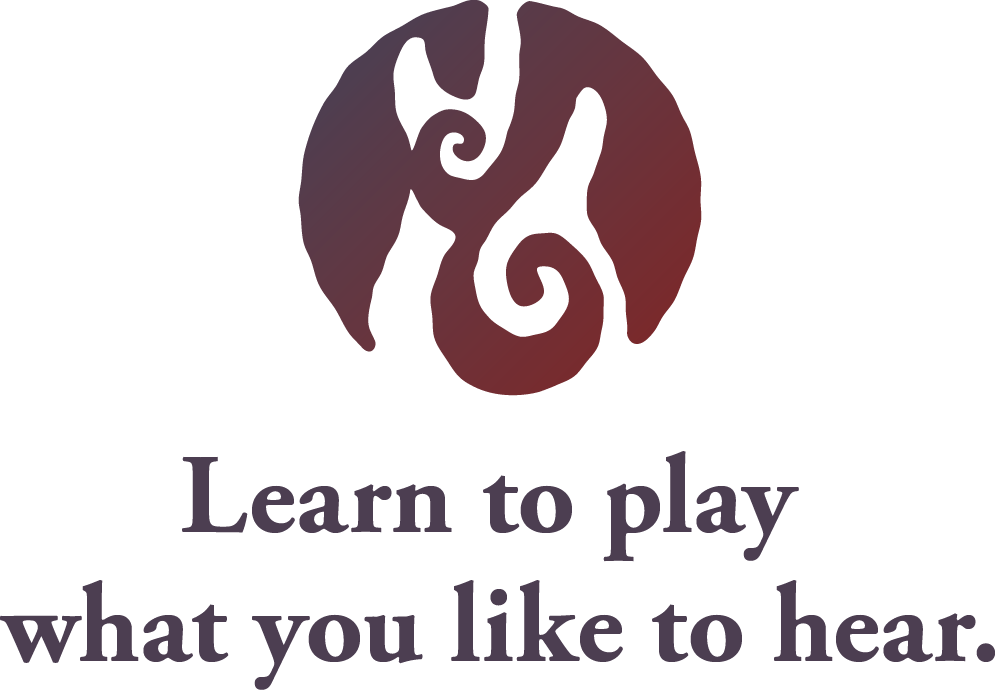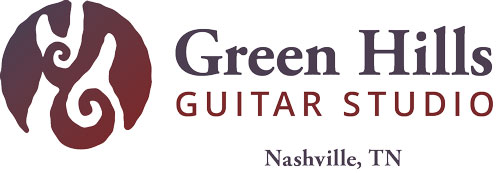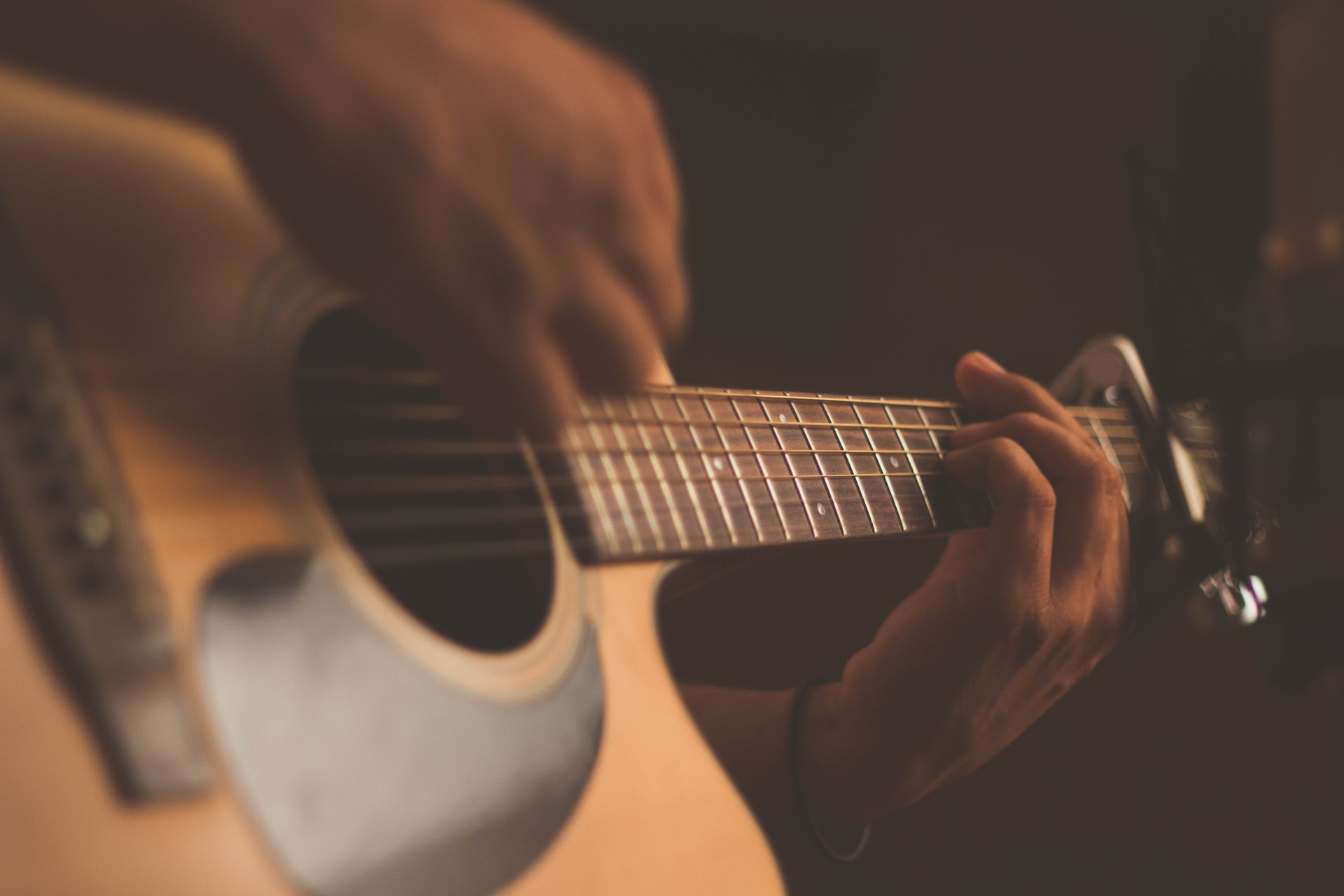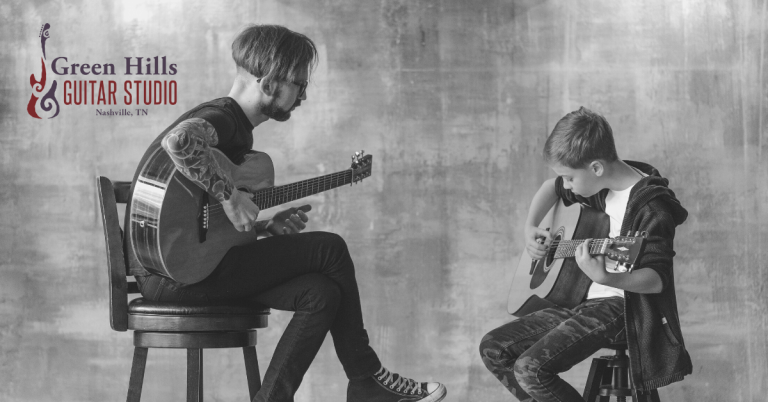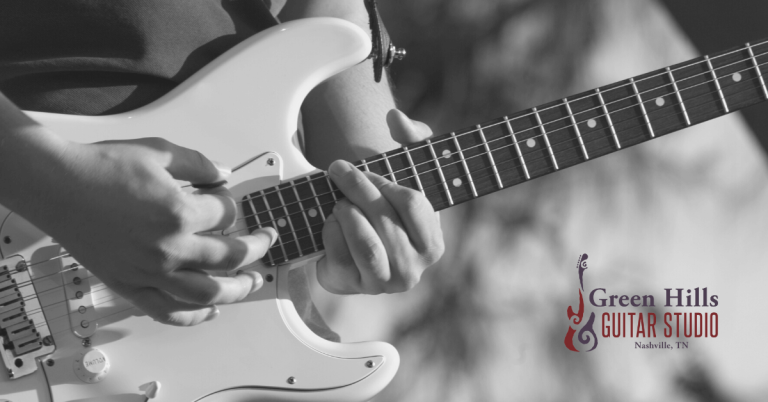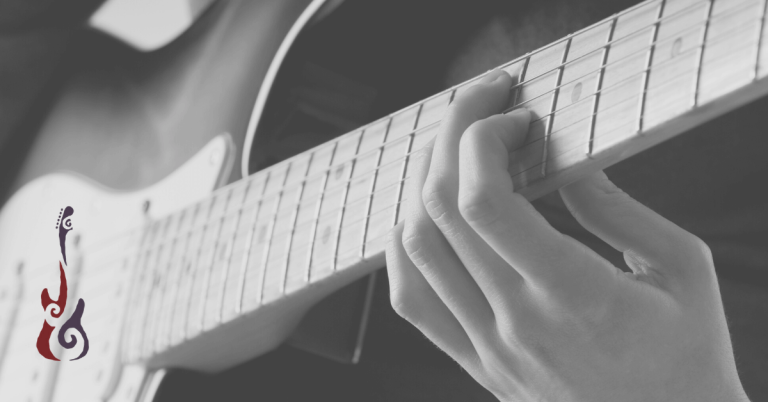Why Do Guitar Players Struggle with Barre Chords?
Barre chords are a common challenge for guitarists of all levels, from beginner to advanced. In this blog, we’ll explore why barre chords can be so challenging to master and provide some tips and tricks for improving your technique.
We’ll also look at common issues that can cause these chords to be particularly challenging. So stick around, and get ready to learn how to tackle barre chords with confidence!
What are Barre Chords?
We all know one when we see one! And then we usually try to fake it, skip it, or ignore it. Barre chords are chords where you have to use the index finger, and sometimes other fingers as well, to hold, or barre, multiple strings at the same time on the fretboard.
If you know how to use a capo, imagine your finger holding down the strings that the capo is holding down, and that’s it!
Barre chords are handy because the shapes are moveable. Like power chords, once you get the shape of the chords, know which note is the root of the chord, and learn the names of the frets, you can play in any key at any time!
We will get into common chord shapes as the foundation of barre chords. Check out this power chord course if you need to learn the guitar neck and get lots of good reps and techniques on hand position! I designed it specifically for these purposes.
Why are Barre Chords Hard to Play?
Everybody struggles to play barre chords when they’re starting out. It’s normal and a predictable speed bump along the way of growing and improving your guitar, songwriting, and performance skills. As a guitar and songwriting instructor, I see it all the time when people are trying to get past the stage of using and playing just open-position chords.
For beginning guitar students and songwriters trying to expand their abilities, barre chords are usually frustrating and intimidating. Barre chords require a deeper investment into your left-hand technique, arm position, strength, and endurance. All these are required to hold the barre chords cleanly and transition smoothly.
But remember, repetition with good awareness is always your ally! Being intentional and patient with your approach is key. Here are some insights and tips that will help you get there faster.
It’s best to think about them and approach them like you are training for something…like a marathon. It’s a bad idea to wake up one day and expect you’ll be able to run 13.1094 miles without some training and preparation. But that’s precisely what we do when we try to learn barre chords.
We beat ourselves mentally and physically, over and over, and then get frustrated that we are so beaten up. There’s a better way!
7 Common Reasons Guitarists Struggle to Play and Change Barre Chords Cleanly
Guitarists often struggle to play and change barre chords cleanly due to several reasons. They require one’s index finger to press down all the strings on a single fret while the other fingers fret the other notes.
This can be very difficult for beginners and even experienced guitarists to master, as it requires strong finger coordination and strength. Trying to play barre chords can lead to fatigue, cramping, and soreness in the hand, making it harder to play the chords cleanly.
Here are the most common reasons why it’s difficult for guitarists to play and change barre chords cleanly:
- A lack of individual finger strength and independence on the fretting hand
- An improper thumb placement on the back of the guitar neck
- Improper placement of the barring finger
- Strength and endurance: a lack of forearm and hand strength
- Not practicing the new barre chord effectively within a chord progression
- The elbow. Yes, the elbow
- Telling yourself, “I’ll never get this!”
Playing barre chords is an essential skill for guitarists and songwriters. It gets you out of those first 3 frets and beyond open-position chords up the neck with a capo. When you learn barre chords, the process opens up the guitar fretboard. Feeling comfortable and confident with navigating the guitar neck is crucial to every guitarist’s growth.
Most people think you have to wrench your hand to play barre chords, and that’s not true. It’s not a lot of force, but enough to get the desired clear chord. It’s more about technique and hand position. There are plenty of 10-year-olds that can play barre chords.
I’m not saying this to make you feel bad. I’m saying this to get you to rework your hand position and technique. Keep coming back to these fundamentals.
Make sure the action on your guitar isn’t too high!
It will be much more difficult if you are playing guitar with strings too high from the fretboard or a nut that is too high. If you think this is the case, take it to your local guitar repair shop for a good setup.
If you are in Nashville, check out One Louder Guitar Repair in Nashville next to our Hillsboro Pike location. Eddie is a great, skilled guitarist, songwriter, and repairman!
One factor that may prevent you from focusing on precision rather than power is your guitar’s setup. If you find that even playing a single note requires quite a bit of force, you want to check out your guitar’s action (string height from the fretboard).
If your strings are too far from the fretboard, which is standard on many new guitars, bring it to a professional to get it set up. It is possible to do it yourself if you’re handy with tools.
Tips for How to Play Barre Chords Effectively
Barre chords are a great way to add texture and complexity to your guitar playing. To play them effectively, you should take a few key steps. First, make sure your fingers are in the right position. The index finger should be placed across all strings of the fretboard, while the other fingers should be placed over specific strings.
Make sure your fingers are close to the frets to ensure a clear sound.

Notice how I am on the tips of my fingers. My first finger is at an angle, and slightly on the side. Applying pressure equally across the first finger is important to get the strings to ring when playing barre chords. If your palm is high, the first two strings will buzz and it will be tough to be on the tips of your fingers.
Next, practice strumming the strings with a smooth, even motion. Start with a slow tempo, and gradually increase the speed as you get more comfortable. You should also practice by playing strings of the barre chord individually to ensure you’re getting a clear sound.
Finally, make sure you’re using the correct amount of pressure. Too much pressure can cause buzzing, and too little will make the chords sound weak. Experiment with the amount of pressure until you find the right balance.
With practice, barre chords can become essential to your guitar playing. Here are some tips for what to think about when learning the mechanics of playing barre chords.
Finger strength and independence
Oftentimes, people try to leap barre chords too quickly. And unfortunately, it’s not uncommon for guitar instructors, who have been successfully and easily playing barre chords for years, to minimize or underestimate the difficulty of first learning barre chords. They are challenging!
Playing barre chords requires a specific approach to your hand position and technique. It also requires more hand strength and endurance. You will feel discomfort in parts of your fretting hand and forearm..that’s normal! You will be using muscles differently, and you’ll feel it.
When we first learn open-position chords, we often have thumbs high up the guitar neck or wrapping around the guitar neck. We also tend to have more of our left-hand palm up on the neck, like we are gripping a bat and afraid to drop it.
Beware of “palm high” positioning
We tend not to be on the tips of our fingers. The pressure and energy we need are trapped at the wrist and not transferred to the tips of the fingers. And even if it were being transferred, the fingers wobble, fold and collapse because…they aren’t strong and independent enough to do what’s being asked of them.
The palm tends to close the space between our fretting hand and the guitar neck. This usually makes the open E or B strings not ring clearly. We can usually get away with this on our open-position chords, but eventually, it shows up in our playing.
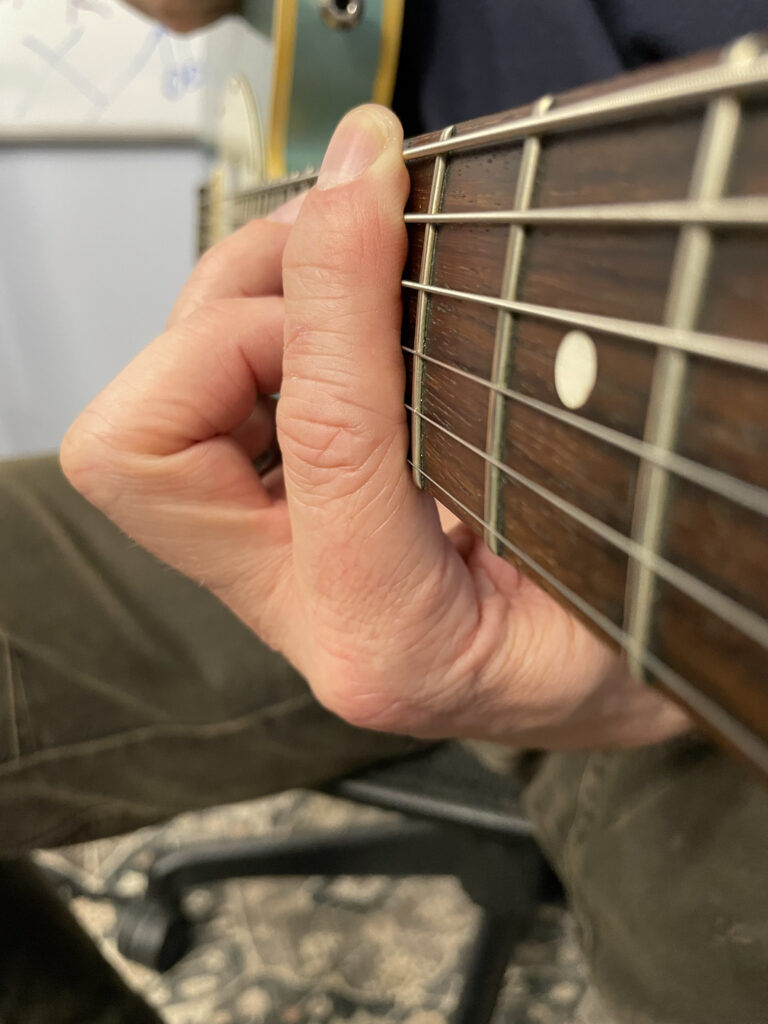
Again, notice the angle of my finger used to barre the strings. Also, you can see the space I have between the neck and my palm. I achieve this by having my thumb low and in a good position on the back of the guitar neck.
Thumb placement
When we play barre chords, we need to locate our thumb on the back of the guitar neck, middle/center. If you think of a Fender Strat with that skunk stripe down the middle of the neck, you want to place your thumb on that line at about 11 o’clock and just in front of your first finger.

Here, you can see the position of my thumb on the back of the guitar neck. Also, notice its placement related to the first finger. Again, I am on the tips of my fingers and have created space between the guitar neck and my palm.
Elbow position
Pull your elbow into your side, so it is touching your ribs. This will help put your hand in an effective position. Remember, you want to squeeze or pinch the guitar neck between your thumb and the fretted fingers. If your palm is on the neck instead of your thumb, or if you don’t create space between the fretboard and your hand, and if you aren’t on the tips of your fingers…you’re sunk!!
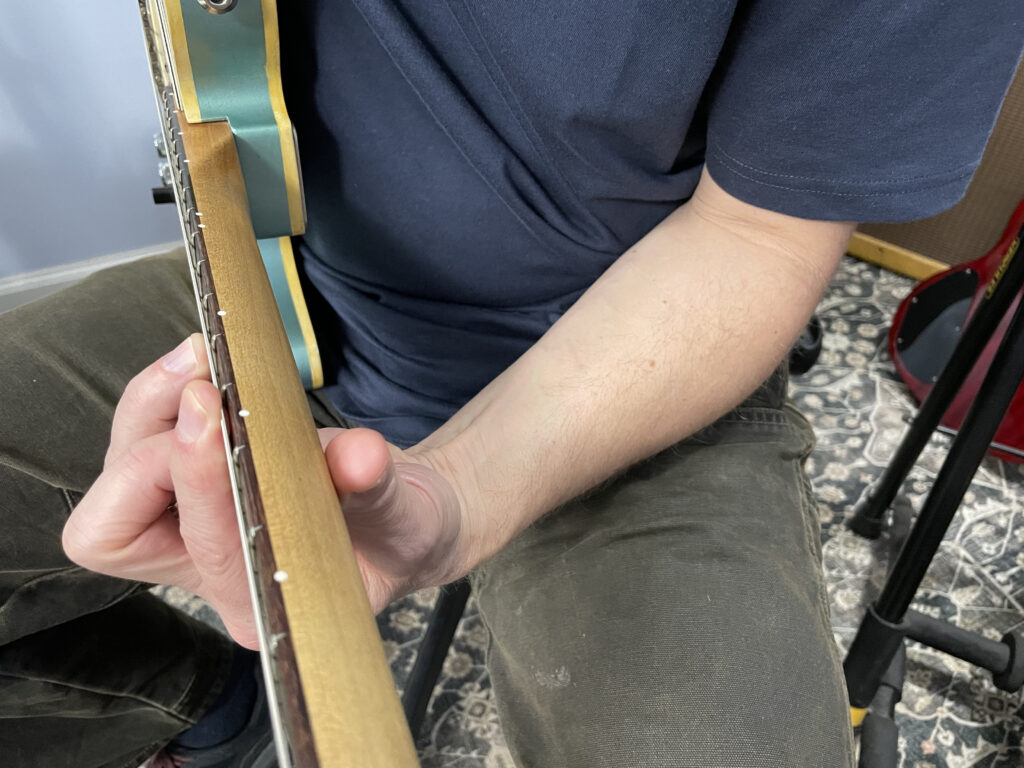
My elbow is pulled into my side. My shoulder is not raised. Notice my thumb position on the back of the guitar neck. Equal pressure is distributed across the strings—tips of my fingers. If you are struggling to play barre chords, these techniques will help you to play the chords cleanly and transition smoothly up the neck.
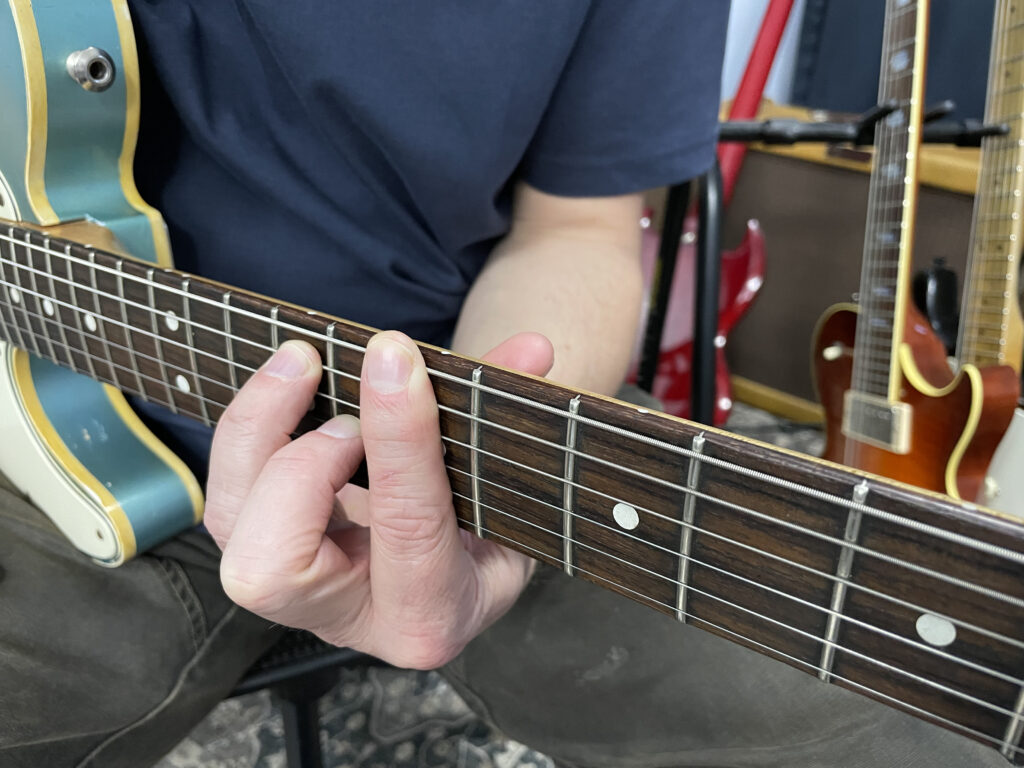
Your first finger and barring
Doing all of the above, including having your elbow at your side, puts your first finger in a position to succeed with your barre chords. The typical thing is to wing your elbow out there and try to get your barring finger flat and straight up. It will never work. It will cause unnecessary strain and tension. Not to mention, you won’t be able to master barre chords and cleanly transition from chord to chord.
Place your first finger at an angle in the fret, tilting towards the headstock of your guitar. It’s okay if part of your finger slightly touches the fret wire. When you squeeze, the pressure will show up in the proper place. If pressing down on the fret wire, shift off of it a bit.
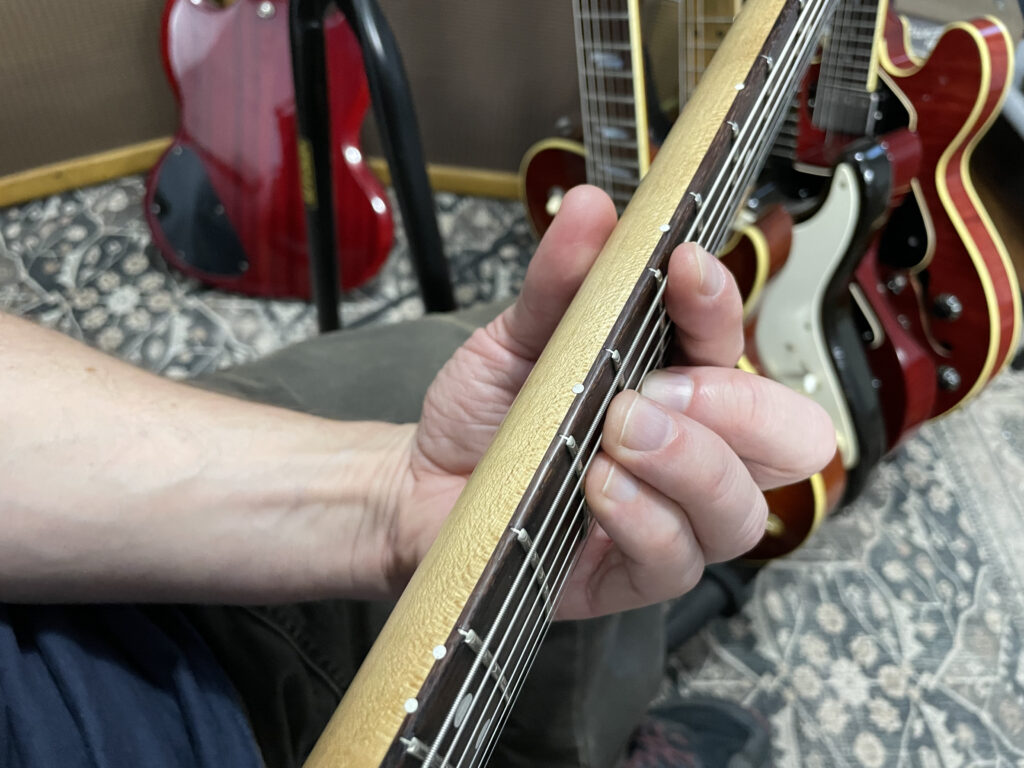
You can see how close I am to the frets. But, the angle of my first finger allows the pressure to be a bit behind the fret. This is possible because of what is going on behind the guitar neck. This positioning allows me to place the energy I need at my fingertips, not wasted and causing pain in my wrist.
Now, you have leverage!
The farther you are from the fret, the harder and more uncomfortable it will be. We are looking for a good finger placement in the fret that will allow you to keep the strings pressed into the neck. You will get rid of that buzz and muting. You have set yourself up to squeeze the guitar neck between the thumb and the barring finger.
Did I say squeeze? SQUEEZE!
Remember to use your whole hand!
Another way to visualize and feel this is to imagine you are using the muscles on the top of your hand to pull the neck toward your thumb. The thumb isn’t passive. It’s receiving and holding that energy. It’s stable and strong.

See how my thumb is in the middle part of the guitar neck? It is at an angle and squeezes the guitar neck between my fingers and thumb. You won’t feel pain in your wrist in this position. However, you will notice you are using parts of your hand you haven’t engaged yet!
If this happens, apply more pressure at the second knuckle of your finger used to barre. But don’t obsess over this. Just be aware of it. It takes time. Just keep working on the hand position and technique I’ve shown you.
Remember, along with learning barre chords, we are learning how to transition in and out of them cleanly and smoothly. Don’t hunker down on one chord for long periods of time. It will cause unnecessary fatigue and frustration. Practice getting into the chord and out of the chord.
Repetition is your friend.
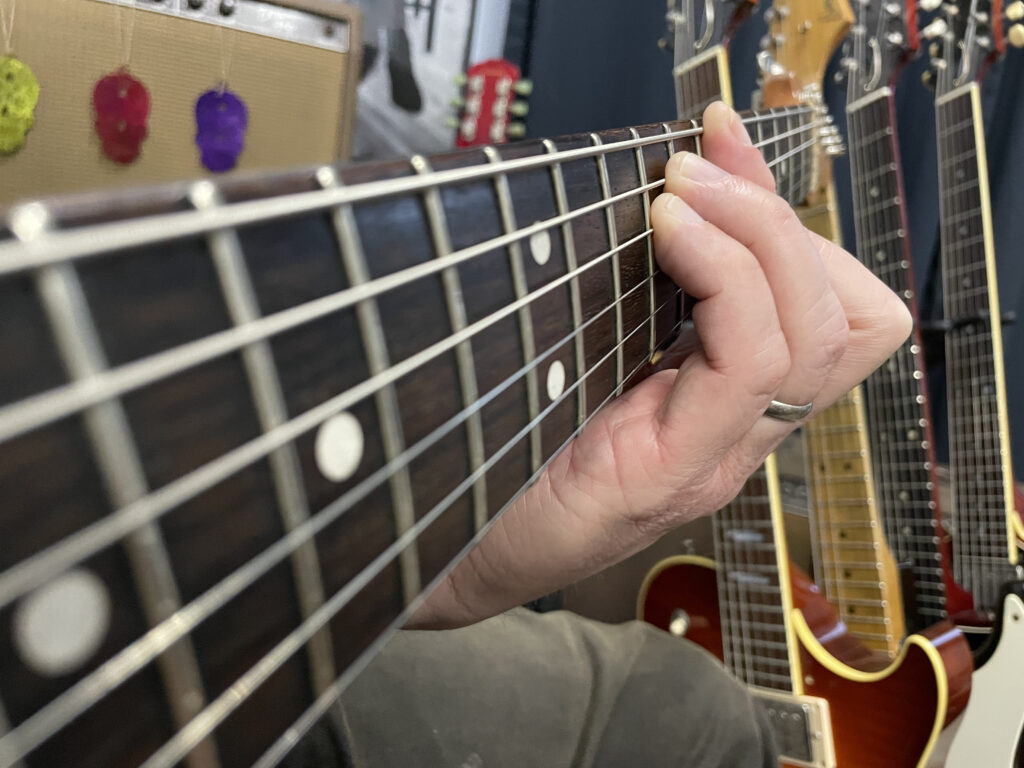
Looking for a Guitar Teacher in Nashville (or Online)?
Barre chords can be a tricky technique for guitarists, but with proper instruction, consistent practice, and the right attitude, anyone can learn the basics and play some of their favorite songs.
Seeking out an experienced guitar teacher can be an invaluable resource for learning to play barre chords and develop good technique, so don’t be afraid to invest in lessons.
At Green Hills Guitar Studio, we offer a variety of online and in-person lessons to help you hone your skills and become a better guitar player. Contact us today to learn more about our lesson options and start mastering barre chords!
Until next time, hang in there and keep practicing. You’re going to get this, I promise!
